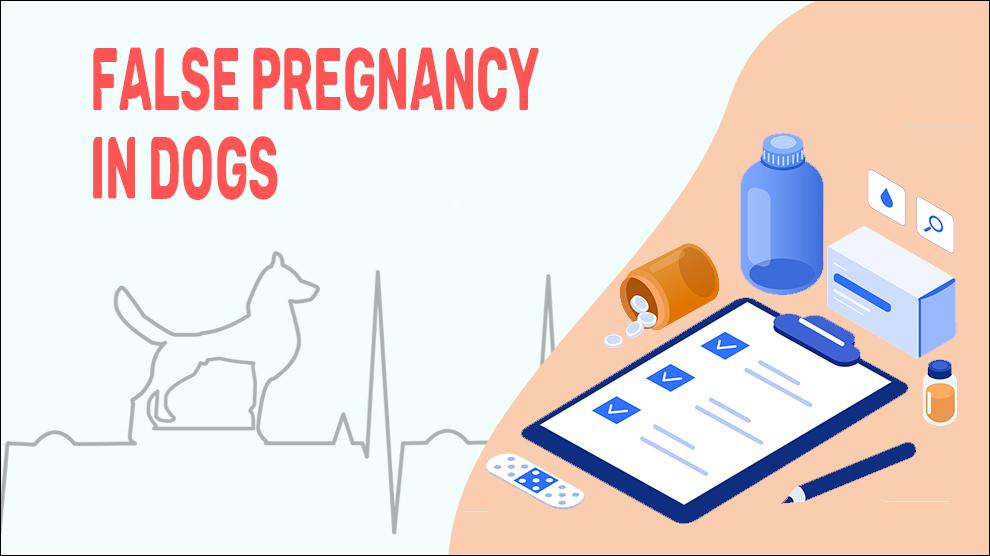False pregnancy is a condition that mimics the pregnancy physical signs in dogs combined with the maternal (mothering) behavior after heat (estrus) in a non-pregnant female dog. Irrespective of whether the dog has mated or not, a majority of unspayed female dogs after the estrus cycle will show some signs of false pregnancy.
Pseudocyesis, Phantom pregnancy, or pseudo-pregnancy is other terms that refer to ‘False pregnancy’. This is usually seen 4- 9 weeks following a normal estrous period.
The female dog's ovaries start to secrete hormones during the estrus cycle (which lasts 2 or 3 weeks), regardless of whether the dog is pregnant or not. The uterus is prepared by these hormones to receive the fetuses and sustain a pregnancy. When the dog gets pregnant, the production of hormones will prolong until the birth of puppies. When the dog doesn’t get pregnant, the hormones rebalance and the signs of estrus subside after 5-7 weeks. Eggs that are released by ovaries wait to be fertilized by a male dog’s sperm. When they do not get fertilized, they gradually fade away. The part that is left over after the egg is released i.e. remaining part of the follicle is called corpus luteum.
Depending on the dog and breed, estrus cycles can start as early as six months of age. Usually, dogs get estrus twice a year but this may also vary as larger breeds get once a year while smaller breeds may get even four times a year.
For most dogs, the circulating hormone levels are elevated and it manifests changes that resemble pregnancy. In the non-pregnant dog, the declining hormone levels send signals to stimulate the development of the mammary gland and false labor. There is no valid answer till now for the occurrence of hormonal changes in a dog that is not pregnant. Sometimes, when the corpus luteum stays in the ovary for a longer time than normal, this can be confused with pregnancy. The increase of prolactin and rapid decrease of progesterone are hormonal changes thought to be responsible for false pregnancy.
Symptoms Of False Pregnancy
- Swelling of mammary glands with or without the production of milk
- Distended abdomen
- Periodic vomiting
- Nesting behavior
- Fluid retention
- Loss of appetite
- Anxiety/ restlessness
- Decreased significance in physical activity
Treatment Options For False Pregnancy
In most cases, medical treatment is not required and it will resolve with time as it can take a few weeks.
- Antibiotics - cephalexin, cefpodoxime, ceftiofur, etc.
- Reducing the effects of prolactin – cabergoline.
- Intravenous fluid and electrolyte therapy to restore and maintain fluid and electrolyte levels.
- Ovariohysterectomy (spaying) is most often the treatment of choice to remove Ovaries and uterus. This surgical removal takes about a maximum of 45 minutes and has little or no risk. There will be no pain and dogs feel only a little discomfort.
Home Remedies For False Pregnancy
- Reducing the behavioral stimulation may reduce the false pregnancy duration.
- The self nursing behavior is stopped by placing e-collars, cone,s or t-shirts.
Prevention Of False Pregnancy
Owners of intact female dogs cannot prevent this condition as the etiology for false pregnancy is not identified. When the dog is not considered for breeding, then the occurrence of false pregnancy can be stopped through surgery.
Ovariohysterectomy (spay surgery) is the only permanent method of stopping false pregnancy in dogs.
Additional Facts For False Pregnancy
1. Causes:
Unspayed female dog: False pregnancy is due to hormonal changes occurring normally in about 6-8 weeks after the estrus cycle. There will be a rapid increase in the hormone prolactin and a decrease in the hormone progesterone.
Spayed dog: The same hormonal changes can also occur in a spayed female dog as a part of the heat cycle. Within 2 weeks of being spayed, the same rapid progesterone decrease happens and this can result in a false pregnancy.
2. Mortality:
There is no documented mortality due to false pregnancy.
3. Diagnosis:
- Complete physical exam
- Complete blood count (CBC), blood chemistry profile
- Electrolyte panel
- Urinalysis
- Bacterial and fungal culture
- Vaginal cytology and culture
4. Prognosis:
The good news is false pregnancy is often rectified on its own within 1-3 weeks and there is no treatment necessary. If signs persist for a longer period or if there are extreme signs, your vet has to get involved but most dogs cross over this period without significant issues.
When To See A Vet
Contact your vet right away, if you notice any of the following:
- Swelling of mammary glands with or without the production of milk
- Distended abdomen
- Periodic vomiting
Food Suggestions For False Pregnancy
- Commercial foods should have high-quality, natural ingredients, with no artificial additives.
- Add fiber to your pup’s diet.
- Brown rice, lukewarm (never hot) chicken soup with Low sodium or chicken breast and cooked vegetables is perfect for the ailing pup.
- Add a couple spoonful of salmon, tuna, mackerel, anchovies or another fish product to your dog’s food.
- Meat-flavored baby food or bland food.
- Semi-moist pet food with boiled chicken.
- Increase water intake or install a pet water fountain.
Conclusion
Spaying will prevent future false pregnancies by stopping the heat cycle and hormonal changes. Remember, if a dog is spayed during an episode of false pregnancy, then the symptoms won’t stop.
When your dog does experience more severe symptoms, veterinary intervention can help relieve discomfort or anxiety until the condition gets cleared up naturally.

















